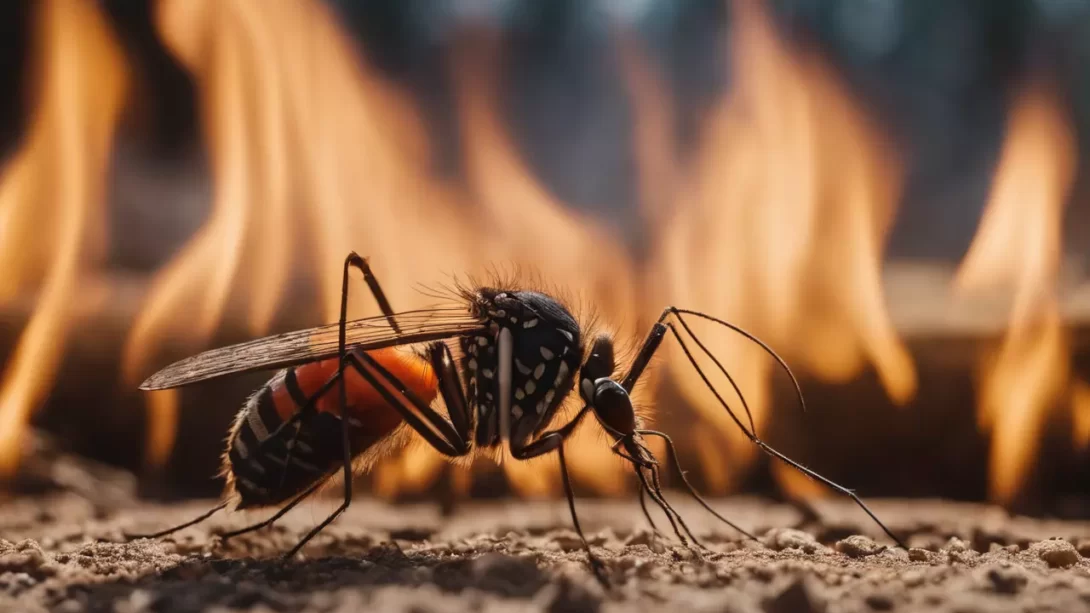Mosquitoes, those tiny, persistent insects, are a common nuisance and can pose health risks due to the diseases they may carry. Communities around the world grapple with methods to keep these buzzing pests at bay, and one intriguing approach that has persisted across various cultures is the use of fire. The notion of fire as a deterrent for mosquitoes is deeply rooted in historical practices, where communities gathered around fires to fend off not only the darkness but also the unwanted company of mosquitoes. This article aims to delve into the age-old question: Does fire keep mosquitoes away? By exploring both traditional wisdom and scientific understanding, we will evaluate the effectiveness of using fire as a mosquito repellent and consider its practical implications.
- 3 Pack (Contains 12 coils & 6 coil stands)
- Each Coil Burns for 5 – 7 Hours
- One Coil covers up to 10 feet
- These Mosquito insect repellent Should be Used only outdoors. It is perfect to use for Patios, porches, Camping trips, Pool areas, backyards and any outdoor activities
Mosquito Behavior
To comprehend the efficacy of fire in repelling mosquitoes, it is crucial to first understand the factors that attract these bloodsucking insects. Mosquitoes are drawn to their hosts through a combination of sensory cues. Chief among these are the carbon dioxide (CO2) emissions, body heat, and specific scents emitted by humans and animals. These factors play a pivotal role in guiding mosquitoes to their next blood meal.
The intricate dance between mosquitoes and their hosts is a result of millions of years of evolution, honing their ability to locate and feed on warm-blooded creatures. Understanding these mechanisms provides a foundation for evaluating how fire might disrupt or influence mosquito behavior. As we explore the historical use of fire and its scientific basis, we’ll delve into whether the age-old practice of lighting a fire can truly keep these relentless pests at bay.
The Traditional Use of Fire
For centuries, communities across the globe have relied on the primal power of fire to stave off mosquitoes. This traditional practice goes beyond a mere means of illumination; it embodies a cultural and communal approach to mosquito control. Whether it be campfires, bonfires, or smoke-producing devices, the use of fire has been ingrained in human history as a method to create a protective barrier against these buzzing intruders. The crackling flames not only illuminate the night but also release smoke, a key component believed to deter mosquitoes. Examining the historical and cultural context of using fire for mosquito control offers insights into the enduring belief in its efficacy.
Scientific Basis for Fire as a Mosquito Repellent
The scientific exploration of fire as a mosquito repellent delves into the chemistry of combustion and its impact on mosquito behavior. When organic material burns, it releases a cocktail of compounds, including carbon dioxide, water vapor, and various volatile organic compounds. These compounds contribute to the characteristic scent of smoke, which has been observed to repel mosquitoes. The rationale behind this lies in the interference of the mosquito’s highly developed olfactory senses.
Studies have demonstrated that mosquitoes, particularly species that primarily rely on olfactory cues for host detection, exhibit altered behavior in the presence of smoke. The smoke disrupts the mosquitoes’ ability to locate their hosts by masking the cues they use to hone in on potential blood sources. While the scientific basis for the traditional use of fire against mosquitoes is promising, the effectiveness may vary based on factors such as the type of fuel burned, the concentration of smoke produced, and the specific mosquito species in question. In the following sections, we will further explore the practical aspects and potential limitations of using fire as a mosquito repellent.
Practical Considerations
Implementing fire as a method for mosquito control requires careful consideration of various practical factors. The type of fire and the fuel used play pivotal roles in determining its effectiveness. While traditional bonfires and campfires may generate smoke, certain fuels, such as those with aromatic properties, can enhance the repellent effect. However, it is essential to balance the desire for efficacy with safety concerns. Safety precautions, such as maintaining a controlled fire and avoiding highly combustible materials, are paramount. Environmental considerations, including the impact of smoke on air quality, must also be taken into account. Furthermore, the effectiveness of fire-based mosquito control may vary in different environments and climates, influencing its practicality as a reliable solution.
Alternatives to Fire for Mosquito Control
While the use of fire has a historical and scientific foundation in mosquito control, it is imperative to explore alternative methods that may offer comparable or enhanced efficacy. In the modern era, various technologies and products have been developed to address mosquito infestations. Mosquito repellents, whether applied to the skin or dispersed in the surrounding air, have gained popularity for their convenience and targeted approach. Additionally, mosquito traps that utilize attractants and UV light have proven effective in capturing and reducing mosquito populations. Window screens and bed nets provide a physical barrier, preventing mosquitoes from entering living spaces.
Considering the environmental impact and safety concerns associated with fire, these alternative methods offer practical and often more targeted solutions for mosquito control. As we weigh the pros and cons of fire in comparison to these alternatives, it becomes evident that a holistic approach, combining various methods, may be the most effective strategy for managing mosquito populations in diverse settings.
Limitations and Challenges
Despite the historical use and scientific underpinnings of fire as a mosquito repellent, there are notable limitations and challenges associated with this method. Factors such as wind direction can significantly impact the distribution of smoke, potentially rendering the protective barrier uneven and less effective. Moreover, the duration of the repellent effect may be limited, requiring a continuous and sustained source of smoke to keep mosquitoes at bay. Safety concerns, including the risk of wildfires in certain environments, add another layer of complexity to the practical implementation of fire for mosquito control. Additionally, the environmental impact of burning organic material must be carefully considered, especially in areas with vulnerable ecosystems.
Another challenge lies in the diverse range of mosquito species, each with unique behaviors and responses to environmental cues. While some species may be deterred by smoke, others may exhibit resilience or adaptability, reducing the overall efficacy of fire as a universal mosquito control method.
Conclusion
In conclusion, the age-old practice of using fire as a mosquito repellent carries both historical significance and scientific merit. The traditional wisdom of communities gathering around fires to ward off mosquitoes aligns with the observed impact of smoke on mosquito behavior. However, practical considerations, environmental concerns, and the need for sustained effectiveness pose challenges to the widespread adoption of fire for mosquito control.
As we navigate the complexities of mosquito management, it becomes evident that a combination of methods, including but not limited to fire, is essential for comprehensive and sustainable control. Alternatives such as repellents, traps, and physical barriers offer practical and targeted solutions, often with fewer environmental and safety implications. Ultimately, the quest for an effective mosquito control strategy requires a nuanced understanding of the limitations and benefits of each method, encouraging ongoing research and the development of integrated approaches to address this persistent challenge.




